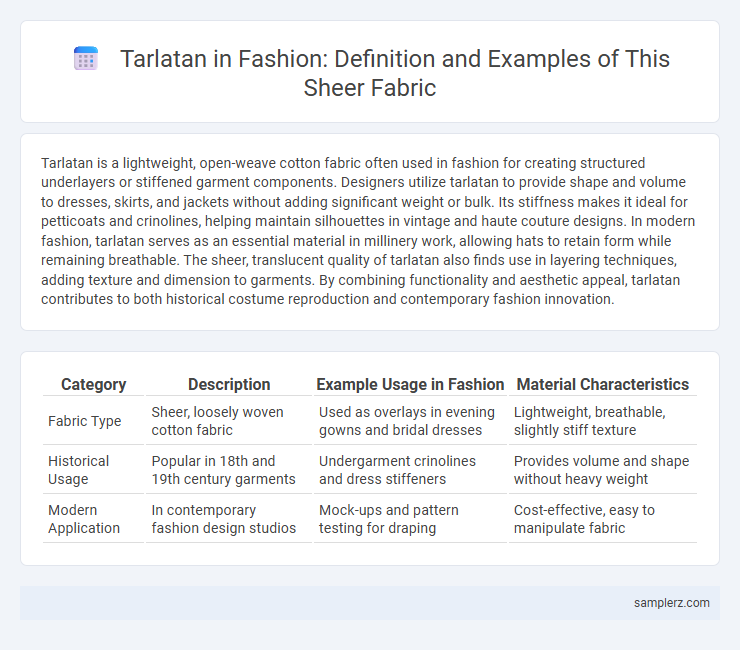Tarlatan is a lightweight, open-weave cotton fabric often used in fashion for creating structured underlayers or stiffened garment components. Designers utilize tarlatan to provide shape and volume to dresses, skirts, and jackets without adding significant weight or bulk. Its stiffness makes it ideal for petticoats and crinolines, helping maintain silhouettes in vintage and haute couture designs. In modern fashion, tarlatan serves as an essential material in millinery work, allowing hats to retain form while remaining breathable. The sheer, translucent quality of tarlatan also finds use in layering techniques, adding texture and dimension to garments. By combining functionality and aesthetic appeal, tarlatan contributes to both historical costume reproduction and contemporary fashion innovation.
Table of Comparison
| Category | Description | Example Usage in Fashion | Material Characteristics |
|---|---|---|---|
| Fabric Type | Sheer, loosely woven cotton fabric | Used as overlays in evening gowns and bridal dresses | Lightweight, breathable, slightly stiff texture |
| Historical Usage | Popular in 18th and 19th century garments | Undergarment crinolines and dress stiffeners | Provides volume and shape without heavy weight |
| Modern Application | In contemporary fashion design studios | Mock-ups and pattern testing for draping | Cost-effective, easy to manipulate fabric |
Historical Origins of Tarlatan in Fashion
Tarlatan, a stiffened, open-weave cotton fabric, originated in the 19th century and became prominent in Victorian fashion for creating structured garments and crinolines. Its lightweight yet durable texture allowed for volume and shape in dresses without excessive weight, influencing the silhouette of women's apparel during that era. Tarlatan's historical use in undergarments and dress supports highlights its significance in shaping the evolution of fashion design techniques.
Tarlatan in 19th-Century Dressmaking
Tarlatan, a stiffened cotton fabric, was widely used in 19th-century dressmaking to create structured garments and add volume to skirts without excessive weight. Its semi-sheer quality made it ideal for underlayers and crinolines, enhancing the silhouette of Victorian dresses. Fashion historians note that tarlatan was essential for achieving the era's iconic bell-shaped skirts and puffed sleeves.
Bridal Gowns Featuring Tarlatan Layers
Bridal gowns featuring tarlatan layers showcase delicate, crisp cotton fabric that adds volume and structure without heavy weight. The semi-transparent nature of tarlatan creates a romantic, ethereal look in wedding dresses, highlighting intricate lace appliques beneath. Designers value tarlatan for its breathability and ability to hold shape, making it a popular choice for layered bridal silhouettes.
Tarlatan in Haute Couture Collections
Tarlatan in haute couture collections serves as a lightweight, sheer fabric often used for creating structured yet delicate overlays and underskirts that add volume without weight. Designers integrate tarlatan to enhance silhouette definition while maintaining breathability, making it ideal for layered gowns and intricate detailing. Its crisp texture and subtle translucence provide a sophisticated contrast against luxurious fabrics like silk and velvet, elevating runway designs with tactile depth and refined elegance.
Tarlatan Use in Vintage Petticoats
Tarlatan, a stiffened cotton fabric, was extensively used in vintage petticoats to create volume and structure beneath skirts and dresses. Its lightweight yet durable nature allowed for comfortable layering while maintaining the desired silhouette in mid-20th-century fashion. Collectors and vintage fashion enthusiasts often seek authentic tarlatan petticoats for their historical accuracy and timeless elegance.
Runway Looks Showcasing Tarlatan Fabric
Runway looks showcasing tarlatan fabric highlight its crisp, translucent qualities, often used in voluminous skirts and structured gowns to create dramatic silhouettes. Designers like Christian Dior incorporated tarlatan to add texture and lightness, enhancing movement and visual interest on the catwalk. The fabric's durability and ability to hold shape make it ideal for avant-garde designs and haute couture collections.
Tarlatan as a Structural Fashion Material
Tarlatan, a stiffened, loosely woven cotton fabric, is widely used in fashion as a structural material to create volume and shape in garments such as petticoats and underskirts. Designers leverage its lightweight yet rigid qualities to support delicate outer fabrics, adding texture and architectural interest without adding bulk. Its breathability and ease of manipulation make tarlatan essential for constructing corsetry and sculptural dress elements in haute couture collections.
Modern Designers Embracing Tarlatan
Modern designers such as Alexander McQueen and Viktor & Rolf have embraced tarlatan for its lightweight, crisp texture that adds volume without heaviness. Tarlatan is often used in structured skirts, bodices, and veils, providing an airy yet defined silhouette that aligns with contemporary avant-garde aesthetics. Its versatility allows designers to experiment with layering and transparency, making it a staple fabric in innovative runway collections.
Styling Tips for Tarlatan Garments
Tarlatan, a stiffened cotton fabric, adds structure and volume to garments, making it ideal for layering skirts, petticoats, and evening wear. Styling tips for tarlatan include pairing it with soft, flowing fabrics like silk or chiffon to balance rigidity and create visual contrast. For a modern twist, incorporate tarlatan under sheer dresses or as an accent in sleeves to enhance texture and dimension without overwhelming the silhouette.
Tarlatan Accessories: Veils, Bows, and More
Tarlatan accessories like veils, bows, and scarves add delicate texture and vintage charm to fashion ensembles, often crafted from crisp, lightweight cotton fabric. Designers incorporate tarlatan in bridal veils for its sheer yet structured appearance, enhancing elegance without heaviness. Bows and trims made from tarlatan provide a subtle emphasis on detailing, complementing haute couture and ready-to-wear collections alike.

example of tarlatan in fashion Infographic
 samplerz.com
samplerz.com